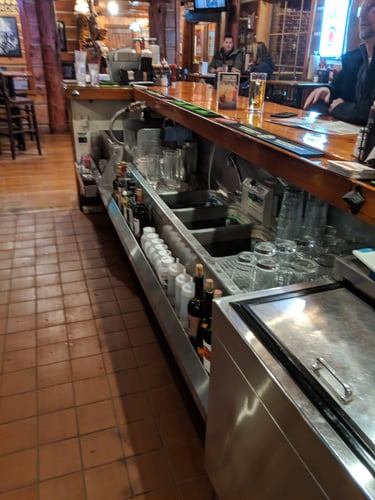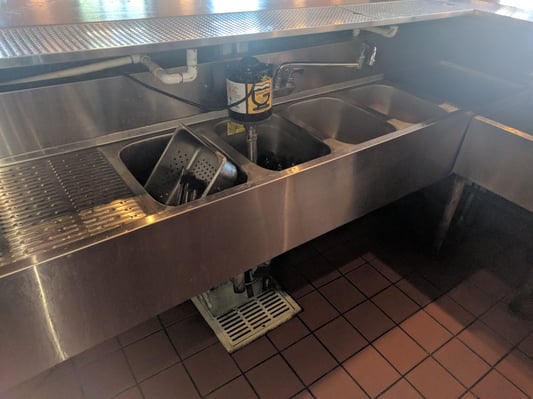Welcome to another 86 Repairs Guide! In this series, we provide valuable data and maintenance and troubleshooting information for the equipment and infrastructure found in your restaurant. We hope this information will help you and your team become more informed about repairs and maintenance (R&M)—and save you time and money along the way.
Have you hugged your local bartender lately?
Okay, we can’t really recommend that without their consent. Let’s think about just how stressful their job is—making drinks for every table and handling the customers sitting directly in front of them who are watching every move.
They’re not only taking orders, but also flagging anyone who’s consumed too much alcohol, dodging poor attempts at flirting, and acting as a resident therapist.
It’s easy to imagine how quickly they can start drowning when their bar sinks stop working. So, we’re offering some big tips to the bartenders of the industry so they can keep their bar sinks—and income—flowing.
Table of Contents
What is a bar sink?
If you own or operate a bar, or if your restaurant serves alcoholic beverages, a bar sink is a must. It’s smaller than the sinks found throughout the kitchen to wash dishes, pots, and pans.
Bartenders typically use bar sinks to empty the last of customers’ drinks before they put the dirty glassware in a bus tub or crate. They’re also useful for minor prep work, like slicing lemons and limes before a shift.
Think about the mix of yeasty beer, sugary soda, and sticky citrus that’s poured into the sink. It’s a recipe for buildup, mold, and—without proper maintenance—clogs. It can really put a drain on your R&M budget.

Numbers to know about restaurant plumbing
Our general plumbing infrastructure data encompasses equipment like bar sinks. In 2022, restaurants spent an average of $592.80 on each invoice from a plumber.
And although those plumbing issues had a first-time fix rate of 92%, the most common plumbing issues can avoid that first service call completely. Here’s how.
Routine maintenance for bar sinks
Bar sink maintenance only takes a few minutes every day, but it could ultimately save the restaurant hundreds of dollars in vendor expenses. We’ll drink to that.
To start, always make sure that your bar sinks have hot water and that the soap nearby has been refilled. It won’t just help you and your team keep things clean—it’ll also avoid a mark from the health inspector.
When using a bar sink—or any other sink within the restaurant’s walls—look for leaks and drips at the faucet and handles. If you spot any extra wetness, head to our Troubleshooting section for tips on fixing these minor issues.
Bar sinks should be outfitted with a fine mesh colander like this so debris can’t fall through. Never put food—including drink garnishes!—down these drains. It’s a recipe for clogs and a potential breeding ground for fruit flies.
Speaking of fruit flies: clean your drains every night at closing to keep them from settling in. Use drain sanitizer or a bio-enzymatic cleaner to remove the sludge and slime created from beverage buildup. Avoid the bleach, though, since it can damage stainless steel pipes. When the rinse is done, cover the drains with plastic wrap or rocks glasses to avoid releasing any flies you missed into the restaurant.
Have some sinks that don’t see a lot of action? Make sure you’re running hot water through them at least a few times a week. This will ensure they don’t dry up and eliminate any fumes that might come creeping through the pipes.
If you and your staff can commit to these steps daily, your bar sink preventative maintenance should be minimal.
Preventative maintenance for bar sinks
We’re only human. Even the best routine maintenance at your bar sinks won’t give you 100% coverage from clogs, drips, and leaks.
That’s why we recommend a bi-annual preventative maintenance schedule for plumbing. Your plumber will be able to check and clean pipes that are inaccessible to you and your team, like:
- The drain line, below the point where a utensil or snake could reach
- The p-trap, or the curved pipe under your sink, that creates a seal to prevent sewer gas fumes from leaking into your space
- Floor drains, which can hold a lot of extra debris from nightly mopping.
Plumbing preventative maintenance should also include line jetting. Restaurant pipes are narrow—and no matter how often you complete routine maintenance, it’s inevitable that they get coated in additional layers of grease and debris. The more layers on the pipe, the more narrow it becomes. Line jetting can remove those layers and help your team stay in their flow.
For more details on line jetting, read The 86 Repairs Guide to Restaurant Grease Traps.
Bar sink maintenance requires you and your staff to be proactive. So what should you do when you need to react to a real-time problem? It’s troubleshooting time!

Bar sink troubleshooting tips
Before you call a plumber to investigate bar sink issues, try these troubleshooting tips for the most common issues that could be backing you up:
Clogged drain
We’ve said it before, we’ll say it again: buildup can easily happen in bar sinks thanks to the sugar and yeast found in the beverages disposed of there. And clogs are common when things like citrus slices or straws find themselves down the drain.
So if your drain won’t, well, drain:
- Check for debris. Fish out any obstructions you might find with a utensil.
- No debris unearthed? Use a drain snake with vigor to see if that loosens the line up.
- Still no movement? Try plunging the line next.
- Finally, use a wet vac or bucket vac to clear water from the sink and try to suction out the pipe.
If you can’t clear a clog with those four steps, call your plumber for service.
Leak present
Leaks can make a messy bar even messier—and wastewater along the way. Before you try identifying the cause of the leak, pinpoint where the leak is coming from and act accordingly.
Leak from hose or pipe
- If there’s a hose or pipe leak and water is backed up, the cause could be a clogged line. Walk through the “Clogged drain” troubleshooting steps.
- Check all connections between the hose or pipe and the water source that you can find.
- If there’s sediment or buildup keeping connections from sealing all the way, disconnect, clean, and reconnect the lines.
- If there’s no buildup, tighten the lines.
- Still leaking? You might have a leak from a hidden spot or a crack in a pipe. Use painter's tape or painter's putty for a short-term repair until you can have a plumber take a look.
Leak from manual faucets
- Is the water supply under the sink on? (Are you sure?) Double-check that along with all other water valves and pipe connections.
- Check all connections on the handles.
- If there’s sediment or buildup keeping handles from opening or closing all the way, remove, clean, and reconnect the handles.
- If there’s no buildup, tighten the screws of the handles.
If the above steps don’t resolve the issue, it could be a cartridge failure. This is a little complicated for your frontline staff to replace, but someone with more specialized expertise like a facility manager should be able to take a look.
Leak from automatic faucets
- Make sure that the sensors are turned on. Might as well check the water supply, too.
- Clean every sensor to make sure buildup isn’t causing an issue.
- Replace the sensor batteries.
Check your user manual for any other potential troubleshooting advice specific to your automatic faucets before calling a plumber.
Odor present
Rotten smells aren’t exactly appetizing to customers who just want to kick back with a beverage. If something smells off in your bar sink,
- Investigate for clogs. If you spot one, follow the “Clogged drain” troubleshooting steps to see if it eliminates the odor.
- If the smell isn’t due to a clog, it could be because the sink’s p-trap is dry.
- Flush the bar sink drain with cleanser to clean any bacteria or other residue.
- Refill the p-trap water reservoir.
Smell still there? That stinks (literally). Time to call a plumber in for the job.
A final note on bar sinks
We propose a toast: Here’s to you and your team avoiding bar downtime and unnecessary R&M expenses! With simple, daily maintenance, bi-annual preventative maintenance, and easy in-house troubleshooting ideas, the party won’t stop.